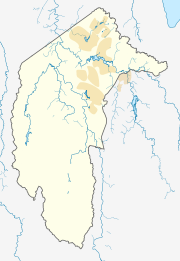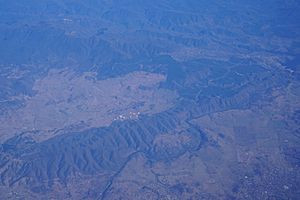Tidbinbilla Nature Reserve facts for kids
Quick facts for kids Tidbinbilla Nature ReserveAustralian Capital Territory |
|
|---|---|
|
IUCN Category II (National Park)
|
|
| Established | 1971 |
| Area | 54.5 km2 (21.0 sq mi) |
| Managing authorities | Territory and Municipal Services |
| Website | Tidbinbilla Nature Reserve |
| See also | Australian Capital Territory protected areas |
Tidbinbilla Nature Reserve is a special protected area covering about 54.5 square kilometers. It is located near Namadgi National Park, not far from Canberra, the capital city of Australia. This land is the traditional home of the Ngunnawal people.
The reserve has a big valley, Tidbinbilla Mountain, and the Gibraltar range. The valley sides are steep and mostly untouched. The lower parts of the valley have been used by both Aboriginal people and European settlers for a long time. Tidbinbilla Mountain is thought to have been a place for Aboriginal initiation ceremonies. The name 'Tidbinbilla' comes from the Aboriginal word Jedbinbilla, which means "a place where boys become men".
Important Aboriginal sites in Tidbinbilla include the Birriagi Rock Shelter. This is the oldest Aboriginal site found in the Australian Capital Territory. Bogong Rocks is another shelter where very old signs of Aboriginal life were found. It was a resting place for bogong moths.
Tidbinbilla Nature Reserve is known as an IUCN Category II protected area. This means it is a national park, managed mainly to protect its ecosystems and for recreation.
Contents
History of Tidbinbilla
Ancient Aboriginal History
Aboriginal people have lived in the Tidbinbilla area for a very long time. At Birrigai, close to Tidbinbilla, archaeologists found the earliest proof of fire use in Australia. This was about 20,000 years ago, during the last ice age. Digs at Hanging Rock show people lived there around 16,000 years ago.
The name Tidbinbilla comes from the Aboriginal word 'Jedbinbilla'. It means "a place where boys become men". The last traditional Aboriginal dance ceremony, called a corroboree, was held here around 1904. You can still find Aboriginal rock paintings in a small cave at Gibraltar Peak.
European Settlement History
Europeans have lived in the nature reserve area for over 100 years. Nil Desperandum and Rock Valley Homestead are old buildings made of rammed earth. They were built in the 1890s by George Green and George Hatcliff.
Nil Desperandum was a four-room house near Hurdle Creek. Henry French Gillman was the first to live there. Nearby, you can also see the remains of a camellia plant farm. There is also the best-preserved eucalyptus oil factory in the ACT.
The Green family lived in the Rock Valley Homestead. Later, George Green's daughter, Elsie Jane, and her husband, Eric Blewitt, lived at Nil Desperandum. This was from the early 1930s to the early 1950s.
Both homesteads were badly damaged by the 2003 Canberra bushfires. Nil Desperandum has since been rebuilt to look like it did originally.
How the Nature Reserve Grew
In 1936, about 8.10 square kilometers were set aside as a public reserve. A koala enclosure was built in 1939. The government bought more land in 1962 to create a national park and animal reserve. This made the park 36.29 square kilometers. Tidbinbilla was later made even bigger to its current size.
In 1966, David Kerr became a park ranger and later the manager. He created many of the walking tracks, animal enclosures, and roads. Under his care, a special program for the endangered Cape Barren goose was started. This helped save the species. In 1969, the first wildlife displays were made. David also brought koalas from Victoria to the park. He set up kangaroo enclosures and areas for water birds. Many picnic spots that families enjoy today were also made by him. David left Tidbinbilla in 1970 to help start Namadji National Park.
The nature reserve was officially recognized in 1971. It is next to the Canberra Deep Space Communications Complex. This complex is part of NASA's Deep Space Network.
In 1988, Tidbinbilla hosted "World Safari," one of the first international TV satellite linkups. The ABC broadcast a live nature show from the kangaroo enclosure. This idea came from David Kerr's daughter, Fiona.
In 2003, big bushfires badly damaged the nature reserve. Many koalas were lost in the fires. The Manager's Residence was also destroyed. The historic Rock Valley and Nil Desperandum homesteads were damaged.
On November 7, 2008, Tidbinbilla Nature Reserve was added to the Australian National Heritage List. It is one of eleven areas that make up the Australian Alps National Parks and Reserves.
Since 2011, Tidbinbilla has been working to breed endangered animals. These include the Northern Corroboree Frog, the Southern Brush-tailed Rock-wallaby, and the Eastern Bettong. They have been very successful in helping these species.
Amazing Animals of Tidbinbilla
Tidbinbilla Nature Reserve is home to many native Australian animals. You might see kangaroos, wallabies, platypus, koalas, lyrebirds, and emus.
The Bendora bushfire in 2003 burned almost all of the park. Many animals were lost. Of the animals kept in enclosures, only a few survived. These included one koala, six rock wallabies, five potoroos, four freckled ducks, and nine black swans.
Fun Walking Tracks
Tidbinbilla Nature Reserve has many walking trails. There is a trail for everyone, from short 30-minute walks to longer hikes of over 6 hours.
Congwarra Trail
The Congwarra trail is great for families. It is about 3–4 kilometers long and takes about 1 hour. This trail starts at the Visitor Centre. It leads to the Nature Discovery Playground and a picnic area. The playground looks natural and fits into the valley.
Birrigai Time Trail
The Birrigai Time Trail is an easy 3-kilometer walk. It takes you back in time to explore Aboriginal and European history. Birrigai means "laughter" in the Ngunnawal language. This mostly flat walk starts at the Visitor Centre. It ends at the Birrigai Rock Shelter.
The Birrigai Rock Shelter is the oldest Aboriginal rock shelter in the ACT. It is very important to the local Aboriginal community. Tools and other items found here are up to 25,000 years old.
Turkey Hill Trail
This short trail is about 500 meters long and takes 15 minutes. You will see big granite rocks and amazing mountain views as you walk up Turkey Hill. To start this trail, drive from the Visitor Centre to the Dalsetta carpark.
Xanthorrhoea Loop
Start this walk at the Dalsetta carpark. Follow the small brown signs along the trail. This trail also crosses parts of the longer Gibraltar Peak trail.
The Xanthorrhoea Loop is named after the Xanthorrhoea plants. These are also called grass trees. You will see many of these native Australian plants along the trail.
Church Rock Heritage Loop
This walk starts at the Flints BBQ area in Tidbinbilla. It is 2.5 kilometers long and is an easy walk.
The walk takes you past old European settler sites from the late 1800s. You can explore the history of the Flints Homestead and Sheedy’s Home Site. The path winds up the hillside and loops around the reserve.
You will find a bench where you can rest and enjoy the mountain views. After seeing the Gibraltar Ranges, it is a short walk to Church Rock. Old diaries from the 1800s say this rock was a meeting place for children's religious lessons. Aboriginal people also used this rock as a meeting place.
Sanctuary Loop
The Sanctuary Loop lets you get close to native animals in their natural homes. This 2.5-kilometer loop is easy and flat. It has clear signs with information about the history, plants, and animals. The path is good for wheelchairs and children. It goes through different animal habitats.
In the Sanctuary, you can see Brush-tailed Rock-wallabies, platypus, echidnas, and birds. It is important not to touch or disturb these wild animals.
Gibraltar Peak Trail
This walking trail is moderate to hard. It is 8.2 kilometers long and takes about 2–3 hours. Starting at Dalsetta, the trail goes through open grassland. Then it climbs to Eliza Saddle. After a short break at the picnic table, you continue up a steep climb through rugged bushland. This leads to the Gibraltar Peak viewpoint.
From the top, you can see 360-degree views of Tidbinbilla Nature Reserve, Canberra, and Black Mountain Tower.








